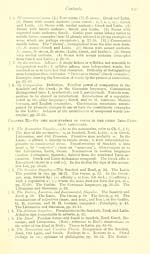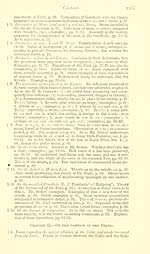Blair Collection > Celtic studies
(26)
Download files
Complete book:
Individual page:
Thumbnail gallery: Grid view | List view

XX ii Contents.
(raradigms of tlie strong and the weak dcclensiou). Comparison of
the Gothic with the Old and the Middle High German; (Paradigm).
Formation of the plural in the modern languages, pp. 45-40. The Li-
thuanian and Slavonian, p. 40.
§ 7. The Accusative Plural. The Sanskrit, Zend, Greek, Oscan, and Latin
compared, p. 47. The Gothic and 0. 11. German, p. 47. The Gothic
-ns. Examples, p. 48. Parallel in Greek, p. 48.
§ 8. The Genitive Plural. The Sanskrit (-«;/0, and Zend (~a7,m), p. 48.
The Latin (-rum), pp. 48-49. The Greek (-wr), p. 49. The Gothic.
The M. and N. H. German, p. 49. The Lithuanian and Slavonian, p. 50.
§ 9. T/<e Dative, Locative, Instrumental, and Ablative Plural. The San-
skrit and Zend, p. 50. Two forms in the Greek and Latin, pp. 50-51.
The Gothic, 0. and M. H. German, pp. 51-52. The Lithuanian and
Slavonian, p. 52.
Paradigm of all the case-endings of nouns in the chief Indo-European Lan-
guages. (The Sanskrit; Zend; Latin; Oscan; Umbrian; Greek;
Gothic; O.H.German; Lithuanian; Old Slavonian ; Old Prussian).
Folding plate facing J}. 52.
CELTIC STUDIES.
Chapter I. — On declension and the degrees of comparison in Irish.
§ 1. Bopp's View of the Aspirations and Eclipses in Modern Irish, and the
modijications ivhich it undergoes through the old Irish forms. Zeuss' de-
termination of the Old forms of the article ; (notes, giving the passages
from Zeuss). Bopp's opinions modified as to the t and the h before
vowels. (Note on dona from donalns, correcting Dr. Ebel's theory re-
garding the 0. Irish dat. plur.), (note on "aspiration" — "Infection",
or " mortificatiou"), (note on the t in the nom. sing. masc. of the Irish
article), pp. 55-56. Bopp's opinion modified as to the nom. plur. masc,
p. 57. Discovery of the neuter, and of the accusative cases in Old
Irish, p. 57.
§ 2. Stems which belong to the several orders and series of Zeuss. Objec-
tions to views of Pictet and Boi)p as to the distribution of the vocalic
stems, i)p. 57-58. Consideration of the words and suffixes Avhich be-
long to the several classes. Examples, pp. 58-59. Examples of forms
in cognate languages, pp. 59-GO. Adjectives, pp. GO-61. Verbal sub-
stantives taking the place of the intiuitive, pp. 61-G2. Forms of the
article, p. 62.
§ 3. Test afforded by Irish Phonology for determining inductively the Primi-
tive Forms oj the Celtic Case-endings. Two close points of contact be-
tween the Irish and the German vocal systems : umlaut of a by / and
M, and fracture of/ and u by a. Examples, pj). 62-63. The vowel of the
ending determmable by the vowel changes in the stem, p. 63. Table
of masc. and neut. endings. (I.) ; (examples), pp. 63-64. (Note : table
of hypothetical endings of masc. and neut.), p. 63. Table of endings
of fern, a- stems ; (examples), p. 64. Table of endings of masc. stems
(III.); (examples), p. 64. Table comparing aaslaut in Old Irish and
N. H. German, p. 64. How the Gaedhelic has been harder than the
Gothic ; (examples), p. 65. Explanation of nmtilations of the auslaut,
p. 65. Table : (Primitive period,— Pre-historic period,— Historic pe-
riod), p. 66.
§ 4. Declension of Consonantal Stems. Zeuss' five classes. Analysis, p. G6.
Table of connnon endings, p. 67. As to the length in the ace. plur.
comparison with the Greek, the Latin, and the Gotliic, p. 67. Obser-
vations on the several cases. Examples, pp. 67, 09. Table of declen-
sion of neutral n- stems, (I.), p. 69. Nouns of relationship in -thar, (II.),
p. 69. Table: (Primitive Period,— Pre-historic Period,— Historic
Period), p. 70. Addition of a "determinative sullix",; (but,— note on
(raradigms of tlie strong and the weak dcclensiou). Comparison of
the Gothic with the Old and the Middle High German; (Paradigm).
Formation of the plural in the modern languages, pp. 45-40. The Li-
thuanian and Slavonian, p. 40.
§ 7. The Accusative Plural. The Sanskrit, Zend, Greek, Oscan, and Latin
compared, p. 47. The Gothic and 0. 11. German, p. 47. The Gothic
-ns. Examples, p. 48. Parallel in Greek, p. 48.
§ 8. The Genitive Plural. The Sanskrit (-«;/0, and Zend (~a7,m), p. 48.
The Latin (-rum), pp. 48-49. The Greek (-wr), p. 49. The Gothic.
The M. and N. H. German, p. 49. The Lithuanian and Slavonian, p. 50.
§ 9. T/<e Dative, Locative, Instrumental, and Ablative Plural. The San-
skrit and Zend, p. 50. Two forms in the Greek and Latin, pp. 50-51.
The Gothic, 0. and M. H. German, pp. 51-52. The Lithuanian and
Slavonian, p. 52.
Paradigm of all the case-endings of nouns in the chief Indo-European Lan-
guages. (The Sanskrit; Zend; Latin; Oscan; Umbrian; Greek;
Gothic; O.H.German; Lithuanian; Old Slavonian ; Old Prussian).
Folding plate facing J}. 52.
CELTIC STUDIES.
Chapter I. — On declension and the degrees of comparison in Irish.
§ 1. Bopp's View of the Aspirations and Eclipses in Modern Irish, and the
modijications ivhich it undergoes through the old Irish forms. Zeuss' de-
termination of the Old forms of the article ; (notes, giving the passages
from Zeuss). Bopp's opinions modified as to the t and the h before
vowels. (Note on dona from donalns, correcting Dr. Ebel's theory re-
garding the 0. Irish dat. plur.), (note on "aspiration" — "Infection",
or " mortificatiou"), (note on the t in the nom. sing. masc. of the Irish
article), pp. 55-56. Bopp's opinion modified as to the nom. plur. masc,
p. 57. Discovery of the neuter, and of the accusative cases in Old
Irish, p. 57.
§ 2. Stems which belong to the several orders and series of Zeuss. Objec-
tions to views of Pictet and Boi)p as to the distribution of the vocalic
stems, i)p. 57-58. Consideration of the words and suffixes Avhich be-
long to the several classes. Examples, pp. 58-59. Examples of forms
in cognate languages, pp. 59-GO. Adjectives, pp. GO-61. Verbal sub-
stantives taking the place of the intiuitive, pp. 61-G2. Forms of the
article, p. 62.
§ 3. Test afforded by Irish Phonology for determining inductively the Primi-
tive Forms oj the Celtic Case-endings. Two close points of contact be-
tween the Irish and the German vocal systems : umlaut of a by / and
M, and fracture of/ and u by a. Examples, pj). 62-63. The vowel of the
ending determmable by the vowel changes in the stem, p. 63. Table
of masc. and neut. endings. (I.) ; (examples), pp. 63-64. (Note : table
of hypothetical endings of masc. and neut.), p. 63. Table of endings
of fern, a- stems ; (examples), p. 64. Table of endings of masc. stems
(III.); (examples), p. 64. Table comparing aaslaut in Old Irish and
N. H. German, p. 64. How the Gaedhelic has been harder than the
Gothic ; (examples), p. 65. Explanation of nmtilations of the auslaut,
p. 65. Table : (Primitive period,— Pre-historic period,— Historic pe-
riod), p. 66.
§ 4. Declension of Consonantal Stems. Zeuss' five classes. Analysis, p. G6.
Table of connnon endings, p. 67. As to the length in the ace. plur.
comparison with the Greek, the Latin, and the Gotliic, p. 67. Obser-
vations on the several cases. Examples, pp. 67, 09. Table of declen-
sion of neutral n- stems, (I.), p. 69. Nouns of relationship in -thar, (II.),
p. 69. Table: (Primitive Period,— Pre-historic Period,— Historic
Period), p. 70. Addition of a "determinative sullix",; (but,— note on
Set display mode to: Large image | Transcription
Images and transcriptions on this page, including medium image downloads, may be used under the Creative Commons Attribution 4.0 International Licence unless otherwise stated. ![]()
| Early Gaelic Book Collections > Blair Collection > Celtic studies > (26) |
|---|
| Permanent URL | https://digital.nls.uk/75771468 |
|---|
| Description | A selection of books from a collection of more than 500 titles, mostly on religious and literary topics. Also includes some material dealing with other Celtic languages and societies. Collection created towards the end of the 19th century by Lady Evelyn Stewart Murray. |
|---|
| Description | Selected items from five 'Special and Named Printed Collections'. Includes books in Gaelic and other Celtic languages, works about the Gaels, their languages, literature, culture and history. |
|---|

